Driving Decisions
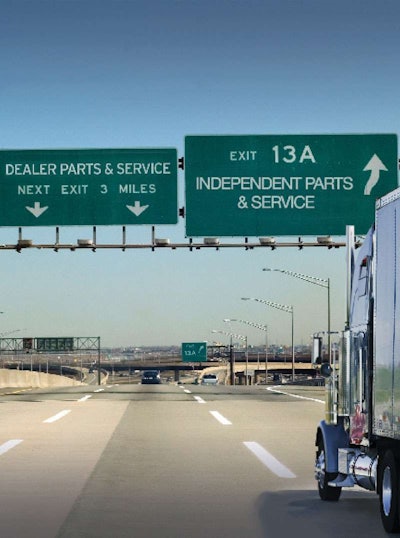
The size of the vehicle service opportunity is staggering: 500,000 service labor hours annually for Class 6 through 8 trucks plus trailers. And, according to Stu MacKay, president of MacKay & Company, if you take an average of the internal costs and the billable rate – about $60 an hour – that translates into a $30 billion market.
That’s a sizeable business opportunity, and one that service providers are doing a poor job of capturing. Even when it makes poor economic sense, many fleets are choosing to perform their own maintenance and repairs.
According to a recent study of fleets conducted by CCJ, sister publication to Truck Parts & Service, even for vehicles still under warranty, two-thirds of all fleets are doing their own preventive maintenance in house, more than half do their own brake work and a third handle steering and suspension work and electrical work in their own shops.
And once the warranty has expired, those percentages climb even higher – with more than three-quarters of the fleets surveyed doing their own PM work, nearly three-quarters doing brake work and close to 70 percent doing steering and suspension and electrical work.
To some extent, fleet size impacts how much work is outsourced. “Typically the smaller the fleet the less work in house because they simply do not have the capabilities,” MacKay says.
But regardless of size, in surveys conducted by MacKay & Co., fleets have repeatedly indicated that they would like to outsource more of their service work, but in fact have ended up doing more work in their own shops.
The complexity of the repair is the most important factor in a fleet’s decision to outsource, according to the survey results. This is followed by the length of time to complete the repair.
WHAT FLEETS WANT
Fleets in the survey cited turnaround time as the most important reason – aside from the quality of the work – in choosing an outside service provider. Nearly 60 percent said that the inability to get a vehicle into an independent repair shop for service in a timely manner was the No. 1 problem they had with outsourcing repairs.
Almost two-thirds had the same issue with dealership service shops. Length of time to diagnose the repair was their second biggest complaint (see sidebar on page 24 for more information on how rapid repair assessment can help alleviate this fleet complaint).
Chas Voyles, service director, Truck Centers, Troy, Ill., says, “The single biggest concern is downtime that the fleet incurs whenever it brings a truck in for service, whether it is a warranty repair or general maintenance. It is about downtime. Time is money to these people and we, as service providers, need to put an emphasis on that.”
Steve Teeple, president, Pollywog Transport, says, “The biggest problem I have is truck turnaround time. To run an efficient fleet does not mean having trucks tied up in the shop for weeks. As a small company with 35 trucks, we need to keep 34 on the road.”
Mark Martincic, fixed operations director at Keith Ely & Associates, agrees that cycle time is a big factor for fleets. “Obviously the truck is not making any money if it is sitting in the shop. Cycle time is an issue at many dealerships, maybe even most, because of the way they do business and because of the inability of the fleet to be able to project what they are going to bring in when.”
While wait times for service seem to be shorter at independent repair garages, fleets have the same expectation of quick service regardless of where they take their vehicles.
According to Martincic, “The fleet wants to know what’s wrong, how much it will cost to fix and when they can have it back.” The channel that can best answer those questions is the one likely to increase its share of the lucrative service market.
MARKET REALITIES
Both independent service garages and truck dealers are vying for fleets’ service business and each have strengths they can capitalize on to try to capture a bigger piece of the service pie. But each channel also has to work to better position itself to be an attractive alternative to fleets.
Dealers pride themselves on having the latest technology needed to repair today’s sophisticated vehicles and believe that gives them the edge over repair garages. “Dealers are required [by their manufacturers] to maintain the technology, special tools and the training to work on today’s trucks,” according to
Allen Phibbs, professional advisor, Keith Ely & Associates.
MacKay concurs and adds, “The dealer is capable of doing virtually anything and he has most, if not all, of the correct diagnostic equipment and electronic equipment to do the work.”
But that doesn’t mean dealers are the only channel making the investment.
“I think there is as much equipment being bought and utilized on the independent side as there is on the dealer side, absent the stuff that is necessary for warranty,” says Bill Wade, partner, Wade & Partners.“The dealer is in the unenviable position of having to buy service tools for whatever make of trucks he sells. The independent buys service tools as necessary for the work he has.”
Having the proper equipment is only part of the equation. Technicians need to be properly trained in using it and must be kept up to date on the latest repair procedures.
“Right now we seem to be having a problem with all the new technology. Even the dealers can’t seem to keep up with training techs to handle the problems,” says Kevin Tomlinson, director of maintenance for South Shore Transportation. “It seems like everyone has one guy who knows how to work on a certain thing. But if you have three tractors in with a problem in that area, and he is the only one who can work on it, it tends to keep my truck in the shop longer. And it seems like this will get worse as technology advances.”
The cost of the repair is another big factor that plays into a fleet’s decision about where to outsource service work. Historically, dealers have been perceived as having higher prices than independents, and in fact dealers’ posted labor rates do tend to be higher than that of independents.
But according to MacKay, many dealers are getting away from the tradition of charging based on the number of service labor hours and the cost of parts. They instead are moving to a menu-pricing model similar to what you see at independent automotive repair shops where, for example, an oil change will be listed at $29.95 and will include oil, filter and a vehicle inspection. “Menu pricing for what I call high volume tasks is one of the first things dealers need to implement to get more service traffic.”
Additionally, MacKay does not believe that fleets fully understand all of the costs associated with doing service in house. “If they took their fixed costs into consideration, it is at least as expensive and maybe more expensive for them to do it in house. But they figure ‘I have the shop. I have the mechanics. It is $90 an hour to take it out and I only pay my mechanics $35, so why not keep it in house?’ However, if they really took an objective look at their total cost, they probably would tend to make different decisions.”
WHAT NEEDS TO BE DONE
So how do you go about helping fleets make different decisions and bring their vehicles to your shop?
According to Martincic, it comes down to three things, “Communicate better, communicate better, communicate better.” Often the service provider does not communicate when work is going to be started on the truck. They also don’t communicate in the middle of the repair very well about what is wrong and what they are doing.
“They save all the communication for the end, once the truck is fixed, and then try to negotiate to close the repair order,” Martincic says.
Voyles adds, “Communication is the central key because money is very tight for fleets and when they have to spend money they need to know what they are spending it on. So you darn well better be communicating with them throughout the process.”
The reason communication is so important, according to Dick Hyatt, CEO, Decisiv, is that it “provides a basis for informed decision making, faster turnaround and more complete and appropriate repairs.”
And while communication is critical, it is not the only thing independent repair garages need to be doing to capture additional service business from fleets. If you are not already investing in diagnostic tools, as well as ensuring that your technicians are fully trained, you will be unable to work on the more technologically advanced vehicles that have been manufactured in recent years and soon will be showing up in your shops, if they’re not pulling into your yard already.
Independent garages have long been concerned about access to repair information and their inability to have instant access to the newest technology can be perceived as a weakness. But, according to Wade, the reality is that “if a manufacturer puts a brand new widget on a truck and it starts falling off eight months later, that is going to be warranty work,” and warranty is an area that most independents typically do not participate in.
“The independent lives on the second through fifth owner,” Wade says, and adds that one of the advantages of the independent channel is its ability to work on heavily mixed fleets “with a whole bunch of different kinds of power and a whole bunch of different kinds of trailers. Independents can work on anything absent the engine.”
That expertise should be highlighted in all outreach to fleets. And reaching out to fleets is imperative if you want additional business. “Make calls,” Wade says. “In order to purchase a vehicle, a fleet has to develop a relationship with a dealer, but there is nothing that says he ever has to develop a relationship with an independent.
“So in order for independents to do the best they can, they should be out making calls. And there is a real scarcity of independents who really sell and market their services properly.”
Another thing that can help you is knowing the profile of the fleet. Martincic suggests you know on average how many trucks a month a fleet brings to your shop for service, what days of the week they typically bring them in, etc. “A little bit of tracking information can help you predict more closely, never exactly, but more closely, when they are going to get the trucks to you and what types of repairs they typically have done.” This can help you be better prepared to provide service more quickly to that customer.
In the end, remember that in order to stay competitive, fleets have to reduce their operating costs. Downtime is the biggest cost for many fleets, according to Martincic. Anything you can do to help them reduce downtime will result in big rewards, in the form of repeat business, for you.
Or as Wade puts it, “Everybody, whether you are an independent, a truck dealer, a truck manufacturer or a component supplier – anybody in the whole service side of the aftermarket – your goal is to make that truck run.” n
Survey results, unless otherwise noted, are from the CCJ Fleet Outsourcing Survey, June 2010.

58.2% Complexity of the repair
7.9% Cost of the repair
0.6% Parts availability
17.4% Length of time to complete the repair
8.9% We outsource all of our maintenace
7% Other

35.8% Turnaround timeirector of operations, Gateway Service Center, St. Louis, Mo., concurs and adds, “The hardest ,” Bill
25.9% Cost
7% Location
17.4% General reputation
1.6% Communication
9.8% Affiliation with a particular truck manufacturer
2.5% Other
The Other Side of the Coin
While fleets are very vocal about their issues with service, service providers also have issues with their fleet customers.
In a recent survey of Truck Parts & Service readers, half of the survey respondents cited timeliness of payments as their biggest area of concern. However, nearly 30 percent indicated the timeliness in fleets authorizing repairs as their No. 1 concern and 31.2 percent ranked it No. 2. Dave Fish, vice president, Eck’s Garage, Muncy, Pa., sums up the frustration of many independent garages: “A lot of fleets require us to call for authorization to work on a truck when a driver shows up. They don’t let us know they have a truck coming in and then when we make our call to get authorization, sometimes we are put on hold from five minutes up to 45 minutes and once in a while longer.”
He continues, “Then after the complaint is diagnosed we have to call again and go through the same scenario. Then we have to call again when the repairs are done.”
Dave Dettman, director of operations, Gateway Service Center, St. Louis, Mo., concurs and adds, “The hardest problem to resolve is the long wait times and the transfer of information to get authorization and POs and payments. The direct contact of individuals able to resolve repair issues also is difficult to resolve.”
And while these things can be frustrating and can slow down your operation, it is important to remember one thing: “Right, wrong or in between, the fleet is the customer,” Bill Wade, partner, Wade & Partners, says. “His expectations by definition can’t be unrealistic because if he wants to get his truck fixed he is going to find somebody who satisfies his expectations.” n
What Have You Got to Say?
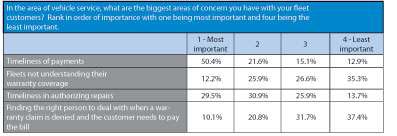
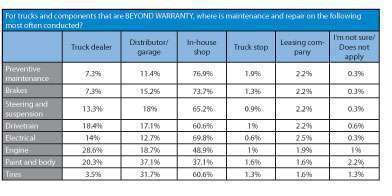
What is the most important thing an independent distributor/garage could do to win more of your business?
* 33.2% Offer more competitive prices
* 26.3% Improve turnaround time
* 8.9% Improve parts availability
* 2.2% Offer a long-term maintenance contract
* 19.3% Guarantee their work
* 1.6% Provide roadside assistance
* 5.4% Provide nationwide service support
* 3.2% Other
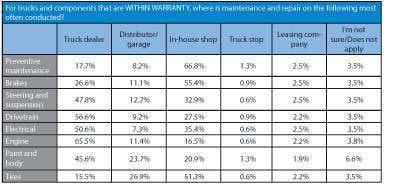
TMC Works on the Problem
Recognizing that there was room for improvement in the service experience, the Technology & Maintenance Council created The Service Provider Committee headed by Chas Voyles, service director, Truck Centers Inc. The objective of the committee is to “promote activities that will improve maintenance practices and relationships relative to both the independent service provider and OEM dealer network and transportation providers.”
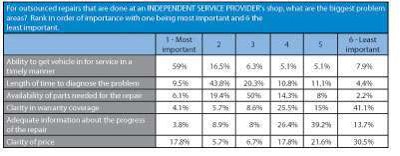
According to Voyles, the top issue that fleets are concerned about is downtime. “Downtime is the single most resonating thing I heard from fleets that are involved in TMC and from customers that I deal with. The Rapid Assessment Task Force is working on building a Recommended Practice to have a model for implementing rapid assessment.”
The Warranty Handling Task Force is charged with establishing a common process for identifying a customer’s extended coverage with a truck manufacturer or component supplier and to develop reporting tools for customers and service providers to submit warranty repairs.

“With the Customer Notification Task Force, we are trying to work toward communicating the status of a fleet’s truck while it is in the possession of the service providers,” Voyles says. This will include things like estimated time of completion, that the truck is ready to be picked up and the final price. “We want to keep in contact with the fleet throughout the entire repair process.”
The Customer Satisfaction Task Force will devise ways to measure “whether as service providers we are doing our job,” Voyles explains.
The Successful Practices Task Force will focus on ways to keep technicians in the bay, which makes them more efficient and results in the truck being repaired more quickly.
The Fair Labor Times Task Force, according to Voyles, has been revamped. “Originally people wanted to establish repair times that could be used universally by all service providers.” However, he says that TMC is not in a position to dictate to people what their business practices should be, so the Task Force is “going to be a medium that you can use to identify labor times used by OEMs and independents so that the customer will know that he is being charged fairly.”
The Quality Control Task Force is working on a Recommended Practice for completing a final quality check on a truck after it has been repaired but before it is given back to the customer.
Voyles says all the Task Forces are making progress and will be meeting next at the TMC meeting in September where he hopes each Task Force can report on what it has done and people can offer comments that will allow Recommended Practices to be built.
There is still work to be done and if you are interested in working on one or more of the Task Forces, contact Voyles at 800-669-3454, ext. 3241, or at [email protected]. n
Triage for Trucks
Two of the biggest fleet demands of service providers are to minimize the time it takes to diagnose a problem and to reduce overall downtime. A growing movement toward rapid repair assessment may help accommodate both.
Rapid repair assessment, currently being reviewed by the Technology & Maintenance Council’s Rapid Assessment Task Force as a Recommended Practice, is basically providing a customer with a quick diagnosis of what is wrong with their vehicle within an hour of the vehicle arriving.
This assessment includes what the initial analysis of the problem is, as well as the estimated time and cost to fix it. The customer can then relay this information to their dispatcher or manager who authorizes repairs and costs. If the estimate is approved, the vehicle is appropriately scheduled for service.
The TMC Service Provider Committee is headed by Chas Voyles, service director, Truck Centers Inc., who has implemented a rapid repair assessment program at his company’s Troy, Ill., location. It includes a 24/7 dedicated bay and specific technicians assigned for rapid assessment. He explains they piloted Freightliner’s rapid assessment program – Decisiv Service Management Platform (DSMP) – and while there were learning curves, the program is now in full swing and working successfully.
“Once it is built and you are serious about it, it is actually pretty simple,” Voyles says. “And what does it all boil down to? To me it is very simple, it is just communication is all it is.”
Voyles says some of the keys to making a program work include:
* Dedicating a service area, preferably a drive-through bay, to the rapid assessment program;
* Assigning at least one service technician per shift to the program who has the best skill set to diagnosis vehicles. This person is the dedicated diagnostic technician (DDT). A service manager or foreman should be assigned to the program as well to manage the business and communication aspects of the program, including interacting with the driver and their supervisor. It doesn’t hurt if this person is also skilled at communicating additional value for other maintenance and repair needs that may exist with the vehicle;
* Parts counterpersons must make DDTs their priority before any other duty; and
* The service managers need to completely buy-in to the program.
As Voyles points out, downtime is lost money for fleets, and minimizing the amount of time the customer waits can go a long way in strengthening relationships and securing repeat business.
“To me, their concerns are justified. It is not like a car going into a dealership. The car isn’t making a customer money,” says Voyles. “When a truck comes in, that is their livelihood. That is how they generate gross profit to keep their business afloat, and I think the concerns are justified. I can back that up pretty much with customers that I deal with on my own where I have to call another service provider and beg them or plead with them to get one of our customer’s trucks in their shops. And I get to feel the customer’s pain.” n





